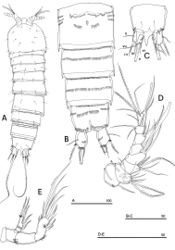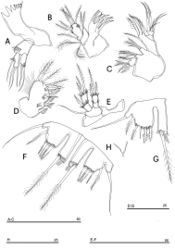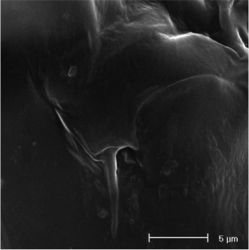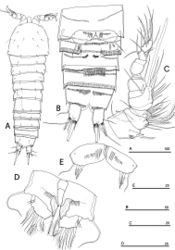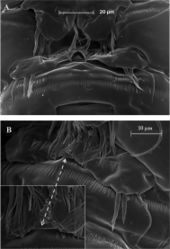Neophyllognathopus bassoti
| Notice: | This page is derived from the original publication listed below, whose author(s) should always be credited. Further contributors may edit and improve the content of this page and, consequently, need to be credited as well (see page history). Any assessment of factual correctness requires a careful review of the original article as well as of subsequent contributions.
If you are uncertain whether your planned contribution is correct or not, we suggest that you use the associated discussion page instead of editing the page directly. This page should be cited as follows (rationale):
Citation formats to copy and paste
BibTeX: @article{Galassi2011ZooKeys104, RIS/ Endnote: TY - JOUR Wikipedia/ Citizendium: <ref name="Galassi2011ZooKeys104">{{Citation See also the citation download page at the journal. |
Ordo: Harpacticoida
Familia: Phyllognathopodidae
Genus: Neophyllognathopus
Name
Neophyllognathopus bassoti (Rouch, 1972) comb. n. – Wikispecies link – Pensoft Profile
Neotype designation
Female neotype completely dissected and mounted in polyvinyl lactophenol, deposited at the Natural History Museum, London (reg. No. NHM.2008. neotype). Other material: 5 ♀♀ and 3 ♂♂ mounted on slides, 5 ♀♀ and 5 ♂♂ processed for SEM; India, 7 January 1999, Y. Ranga Reddy coll.; 1 ♀, slide code 66/49, 1 ♀, slide code 66/53, 1 ♂, slide code 66/55, Santa Fe, Bantayan island, Pooc, Philippines, V. Cottarelli coll. (see Bruno and Cottarelli 1999[1], for locality details).
Neophyllognathopus bassoti is proposed herein as new combination for Phyllognathopus bassoti assigned by Rouch (1972)[2] in the original description to the genus Phyllognathopus. According to ICZN (2000)[3], a neotype may be designated when no name-bearing type specimen (i.e. holotype, lectotype, syntype or prior neotype) is believed to be extant and an author considers that a name-bearing type is necessary to define the nominal taxon objectively (Article 75.1). Article 75.3 asks also for qualifying conditions for the establishment of a neotype; among them: …. a statement that it is designated with the express purpose of clarifying the taxonomic status or the type locality of a nominal taxon (Article 75.3.1), and the author’s reasons for believing the name–bearing type specimen(s) … to be lost or destroyed, and the steps that have been taken to trace it or them (Article 73.3.4).
The specimens on which Rouch (1972)[2] based the original description of Phyllognathopus bassoti no longer exist, and most part of the Rouch’s collection has been lost (Rouch, in litt.). Consequently, the ICZN (2000)[3] recommendation 75A cannot be met, because no extant paratypes or paralectotypes, nor topotypic specimens are available, in order to select among them a neotype. The need to clarify the taxonomic status of this species, which is ranked herein to a new genus, imposed to follow another formal procedure, which, if not completely fulfills the ICZN rules (Article 75.3.6), is accepted by the Code (Article 76.3): the place of origin of the neotype becomes the type locality of the nominal species-group taxon, despite any previously published statement of the type locality. Following these arguments, a consistent population from India has been selected to establish the new genus, together with additional material from Indonesia. It is relevant to observe that other researchers have given consensus (Bruno and Cottarelli 1999[1], Karanovic and Ranga Reddy 2004[4]) on the attribution of both populations to the species Phyllognathopus bassoti described by Rouch (1972)[2] from the Lake Wisdom (New Guinea).
Neotype locality
India, Andhra Pradesh, town of Guntur, Brindavan Gardens, domestic water reservoir filled by a freshwater bore well; coordinates: approx. 16°18'N, 80°29'E (see Karanovic and Ranga Reddy 2004[4], for more details).
Description based on the designed neotype
FEMALE NEOTYPE. Body length, measured from tip of rostrum to posterior margin of caudal rami, 348 µm. Habitus slightly dorsoventrally flattened (Fig. 17A), with no clear demarcation between prosome and urosome. Body depigmented and eyeless. Integumental dorsal window on cephalosome not confirmed. First pedigerous somite free. Integument without surface pits, moderately sclerotized. Cephalosome rounded; rostrum elongate, clearly articulated to cephalosome. Hyaline frills of cephalosome, somites bearing P1-P4 and urosome plain both dorsally and ventrally (Fig. 17 A, B). Cephalosome and both thoracic and abdominal somites (except fourth urosomite) with cuticular ornamentation represented by dorsal sensilla. P5-bearing somite with lateral paired and large pores (Fig. 18A). Female genital field located between first and second third of genital double-somite. Genital apparatus simplified; copulatory pore located at half of genital double-somite. Seminal receptacles laterally located and condensed close to the lamellar sixth legs. Three spinular processes on free distal margin of anal operculum (Figs 17A–C). Caudal rami sub-quadrate, with incomplete setal pattern (6 setae). Dorsal seta inserted close to free distal margin of caudal ramus (Fig. 17C).
Antennule (Fig. 17D): consisting of 8 segments, segments 1 and 2 with long tube-pores. Armature formula: 1-[1], 2-[8], 3-[5], 4-[1 + (1 + ae)], 5-[1], 6-[3], 7-[4], 8-[6 + (1 + ae)]. Aesthetasc on segment 4 very large and long, well overreaching the last antennulary segment.
Antenna (Fig. 17E): exopod and armature of the second endopodal segment as in Phyllognathopus and Parbatocamptus. Exopod 1-segmented, with 3 lateral and 2 apical setae.
Mandible (Fig. 19A): mandibular palp biramous, basis with inner spinule row, exopod with 1 apical and 1 inner setae; endopod with 1 inner, 1 subapical and 2 apical setae. Armature of maxillule (Fig. 19B) and maxilla (Fig. 19C) as in Phyllognathopus.
Maxilliped (Fig. 19D): phyllopodial, lamelliform, 1-segmented. Clear trace of ancestral 2-segmented condition marked by the presence of both outer and inner incisions. Armature consisting of 11 elements: 1 strong spine inserted at inner corner of former segment 1; 4 spines and 1 spiniform short seta inserted along inner margin, 5 bipinnate setae in apical position, armature topology basically referable to that of Parbatocamptus.
P1-P3 with 3-segmented exopods and endopods. P4 with 2-segmented exopod and endopod. P1-P3 praecoxa well developed. P4 praecoxa absent (Fig. 19E). P1 exopod of about the same length of endopod. P2-P3 exopods longer than endopods, endopod not overreaching exp-2, fitting the original description (Rouch 1972[2]) and the subsequent ones (Bruno and Cottarelli 1999[1], Karanovic and Ranga Reddy 2004[4]).
P5 (Fig. 19F, G): free, with clear articulation to P5-bearing somite; right and left legs separate; baseoendopod and exopod coalescent, deep incision marking original segmentation between them; endopodal lobe well developed, elongate, rectangular in shape, longer than exopod, bearing 1 long pinnate seta, subdistally inserted, close to outer margin, and 2 spinule rows, the proximal one composed by tiny elements, the distal one of long spinules; exopodal lobe well discernible, with armature consisting of 4 (rarely 5 elements, observed in only one female) elements, the outermost seta inserted in subdistal outer position, the remaining ones in apical position; the outer apical seta slender and bipinnate, the remaining two spiniform. Basipodal outer seta present.
P6 (Figs 19H, 20): rudimentary, consisting of small paired chitinous lamellar plates not coalescent along medial margin, partially covering seminal receptacles. Armature consisting of 1 short smooth spine with rounded tip on each side.
Male
No marked sexual dimorphism in body size. Body length, measured from tip of rostrum to posterior margin of caudal rami, 335 µm. Rostrum and ornamentation of cephalosome as in female (Fig. 21A). Male urosome consisting of 6 segments (Fig. 21A), third and fourth urosomites with deep ventral sockets (Figs 21B, 22A); socket on third urosomite plicate, with smooth free distal margins, and 2 setules laterally inserted close to the socket opening (Fig. 22B); socket on fourth urosomite with ornamented anterior margin, armed by strong spinules covering the opening (Fig. 22C). Anal somite with paired sensilla on dorsal side. Anal operculum protruding free distal margin of anal somite and extruded in 4 strong spinular processes, rarely 5 (in general anal operculum in males more armed than in females) (Fig. 18B). Antennule (Fig. 21C): basically 9-segmented, geniculation between segments 7 and 8; penultimate and last segments, each with suture line marking original segmentation between former segments 8 and 9, and 10 and 11, respectively. Long tube-pores on segments 1 and 2. Armature formula: 1-[1], 2-[8], 3-[8], 4-[1], 5-[7+(1 + ae)], 6-[2], 7-[1], 8-[1], 9-[10 + (1 + ae)]. P5 (Figs 21D, 23A): free, with clear articulation to P5-bearing somite; right and left legs separate, intercoxal sclerite rudimentary but still discernible (Figs 21D, 23B). Basis of each leg well developed, representing most part of each leg; endopod rudimentary, consisting of a sclerotized and strong process articulated to basis. Row of surface spinules inserted near articulation between endopod and basis. Endopodal seta bipinnate, inserted on posterior surface of the endopod, close to its articulation to basis. Exopod distinct, clear articulated to the basis, wide and short, with unusual topology, being placed at the inner free distal margin of basis; exopodal armature consisting of 6 elements, all of which in apical position. Inner spinulose seta short and distinctly curved inward, the remaining setae of about the same length, 2 of which (the second and the fourth, beginning from the inner margin of the exopod) are respectively bipinnate and unipinnate; the remaining 3 smooth and slender, frequently closely adherent to each other and not easily discernible as distinct (Fig. 24). Male P6 (Figs 21E, 25A–B): right and left legs distinct, closely adherent along inner margin, and symmetrical, each leg consisting of a well developed lamellar plate, with some spinule rows on the anterior surface. A membranous lamella is observable between right and left P6 (rudimentary intercoxa?) (Fig. 25B); armature consisting of 2 inner spines of different length and 1 outer naked seta.
Taxon Treatment
- Galassi, D; Laurentiis, P; Fiasca, B; 2011: Systematics of the Phyllognathopodidae (Copepoda, Harpacticoida): re-examination of Phyllognathopus viguieri (Maupas, 1892) and Parbatocamptus jochenmartensi Dumont and Maas, 1988, proposal of a new genus for hyllognathopus bassoti Rouch, 1972, and description of a new species of Phyllognathopus ZooKeys, 104: 1-65. doi
Other References
- ↑ 1.0 1.1 1.2 Bruno M, Cottarelli V (1999) Harpacticoids from groundwaters in the Philippines: Parastenocaris mangyans, new species, Epactophanes philippinus, new species, and redescription of Phyllognathopus bassoti (Copepoda). Journal of Crustacean Biology 19 (3):510-529. doi: 10.2307/1549260
- ↑ 2.0 2.1 2.2 2.3 Rouch R (1972) Deux harpacticidae nouveaux de l’ile de Long Island (Territoire de Papouasie et de Nouvelle-Guinée). Archives Zoologie Expérimentale & Générale 113 (1):147-164. doi: 10.1023/A:1013148808110
- ↑ 3.0 3.1 ICZN (2000) International Code of Zoological Nomenclature. Fourth Edition. London: The International Trust for Zoological Nomenclature.
- ↑ 4.0 4.1 4.2 Karanovic T, Ranga Reddy Y (2004) First record of Phyllognathopus bassoti Rouch, 1972 from India, with remarks on the family Phyllognathopodidae Gurney, 1932 (Crustacea, Copepoda, Harpacticoida). Annales de Limnologie 40 (2):121-132. doi: 10.1051/limn/2004010
Images
|
